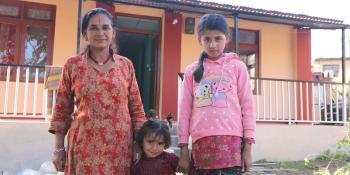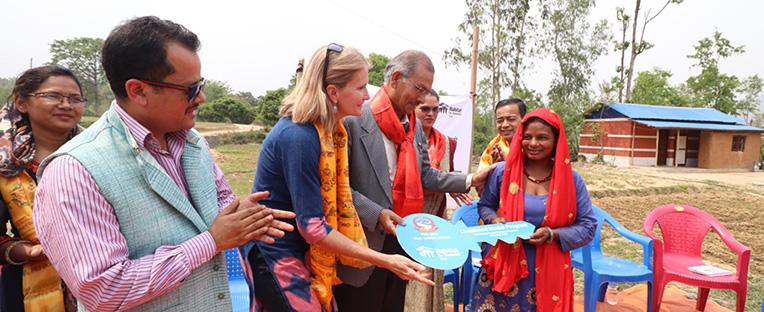
Habitat builds resilient homes through stronger community links.
In the three years since the 2015 earthquake, 45,829 families have been supported with relief and shelter interventions ranging from shelter kits to permanent housing with access to water and sanitation facilities.
MANILA (April 25, 2018) — Three years after the devastating 2015 earthquake, Habitat for Humanity Nepal shares the pride of Dilaka who rebuilt her house in Kavrepalanchok district. “I decided to rebuild my house though I did not have enough resources. With the support of Habitat Nepal, along with the government grant, my family and I now have a safe roof above our heads. I am very proud of my house.”
Dilaka is among hundreds of families who have worked with Habitat Nepal to rebuild their houses based on a homeowner-driven reconstruction approach. As we mark the third anniversary of the disaster, Habitat continues to walk together with affected families and communities on the long road to recovery.
On April 25, Habitat for Humanity joined other organizations including Youth for Human Rights International Nepal Chapter in a candlelight memorial at the Pashupati Nath temple, a world heritage site in Kathmandu. In a dedication ceremony in Baluwa, Kavrepalanchok attended by National Reconstruction Authority representatives and Kavrepalanchok government officials, Habitat Nepal handed over a new house to Chameli, a 35-year-old widow with two young children. The house was built with compressed stabilized earth blocks produced through a livelihood model program that has trained 60 community members in partnership with NRA.

Chameli (far right) receiving a symbolic key from representatives of Habitat Nepal and the National Reconstruction Agency. Her house in Baluwa, Kavrepalanchok was built with compressed stabilized earth blocks. Photo: Habitat for Humanity Nepal/Sameer Bhattarai.
Rick Hathaway, Asia-Pacific vice president of Habitat for Humanity International, says: “At the three-year mark of our response in Nepal, we can celebrate how far we have come because of the support from our donors and partners. Every family needs help when a disaster strikes. By working together with the communities, we have enabled affected families to rebuild their homes, increased the communities’ resilience through training in the Participatory Approach to Safe Shelter Awareness, and improved construction and livelihood skills.” He adds: “The work does not stop here as we are committed to the national reconstruction effort.”
Habitat for Humanity was among the first organizations to respond after the magnitude-7.8 earthquake on April 25, 2018 followed by a strong magnitude-7.3 aftershock on May 12, 2018 struck several districts in Nepal. In the early phase of Habitat’s response following the disaster — said to be the worst earthquake to hit Nepal in 80 years — hundreds of local volunteers were mobilized to clear tons of rubble from affected areas. Temporary shelter kits, water backpacks and winterization kits were also distributed to meet the families’ shelter and other needs during the emergency phase of the response.
The earthquake took away what people had saved and preserved but what it failed to take away was the people’s resilient spirit and the common purpose to rise above the adversity. Thanks to committed donor and partner support, Habitat Nepal is able to complete 692 new houses with another 373 houses under construction. Those who have received training in masonry, blockmaking, plumbing and other livelihood skills now have the opportunities to contribute to the recovery process. As Habitat draws close to completing the projects that have received donor support in Kavrepalanchok and Nuwakot districts, we seek to serve more affected families through building back safer and promoting community resilience.
Some of the challenges still remain — the pace and scale of reconstruction, and the funding gap needs to be addressed. Habitat Nepal’s three Housing Support Service Centers have provided 1,065 families with services that include technical consultations, house designs, and help with site supervision and document preparation to apply for government reconstruction grants. Overall, Habitat Nepal has served the shelter needs of at least 45,829 families from emergency relief to recovery and reconstruction in the last three years To put families and communities in charge of rebuilding their own permanent homes, Habitat Nepal implements its response through a four-pillar approach. The vital sectors comprise social mobilization that helps empower communities to join rebuilding efforts while technical assistance aims to provide improved construction skills for safer reconstruction. Vulnerable households also get non-financial support for income-generating activities through tiered assistance. And lastly, market development helps improve housing value through access to better construction materials and labor.
Gender and social inclusion is promoted in various training. Every one in four persons trained under the Participatory Approach to Safe Shelter Awareness is a woman. In earthquake recovery areas, more women have become active participants in their community’s self-recovery, enhancing their local capacities as trained masons, surveyors and engineers.
Download a copy of the third anniversary report on Habitat Nepal’s earthquake response.
In spite of challenges that the government faces to address the massive housing needs three years after the earthquake, Habitat Nepal will continue supporting earthquake-affected families especially those in underserved and hard-to-reach communities to complement ongoing government housing interventions. With more than 20 years of experience working together with the people of Nepal, Habitat for Humanity with the support of its generous donors, volunteers and supporters will continue to build resilient communities, where families have access to decent and affordable housing. Through shelter, we empower.